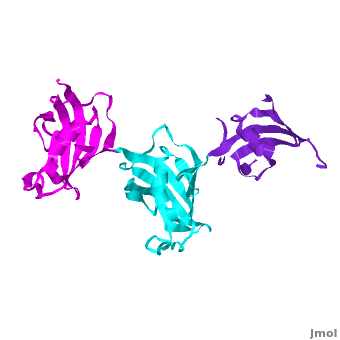Function
FK506 binding protein (FKBP) is a prolyl isomerase related to the cyclophilins. FKBP is a folding chaperone for proteins containing prolines[1].
- FKBP3 is involved in immunoregulation and protein folding[2].
- FKBP8 inhibits accumulation of misfiled proteins in the heart[3].
- FKBP12 is a physiologic regulator of cell cycle[4].
- FKBP12.6 stabilises the Ryan-dine receptor, preventing aberrant channel activation[5].
- FKBP13 is an ER-resident molecular chaperone and has a role in inflammation and fibrosis protection[6].
- FKBP22 has peptidyl prolly cis-trans isomerase activity[7].
- FKBP25 has a role in the repair of DNA double-stranded breaks[8].
- FKBP35 is an essential malarial enzyme [9].
- FKBP36 has a role in spermatogenesis[10].
- FKBP38 is expressed in mitochondria and inhibits apoptosis by recruiting Bcl-2 and Bcl-xL[11].
- FKBP39 may act as a transcriptional modulator of 20-hydroxyecdysone and juvenile hormone transduction[12].
- FKBP42 has a role in morphogenesis and development of higher plants[13].
- FKBP51 is a biomarker of metabolic dysfunction[14].
- FKBP52 has a role in regulation of steroid receptor signaling[15]. See detains in Human FKBP52.
- FKBP59 or Hsp56 has a role in maintaining steroid receptors in an inactive state[16].
- FKBP73 acts as a molecular chaperone[17]. See details in Wheat FKBP73.
For more details see
Relevance
FKBP12 binds the immunosuppressor tacrolimus (ascomycin FK506) which is used against organ rejection and rapamycin[18].
Disease
Mutations in FKBP14 cause Ehlers-Danlos syndrome[19].
Wheat FKBP73 and its comparison with human FKBP52[20]
Ribbon representation of the ; wFK73_1 (residues 1–148) in blueviolet, wFK73_2 (residues 149–266) in cyan and wFK73_3 (residues 267–386) in magenta (3jym). The wFK73_1 domain exhibits electron density only between residues 33–38, 54–69 and 87–148. The bulges and the flaps as well as the N- and C-termini are labeled. The three FK506 binding (FK) domains of wFKBP73 are held together mainly by situated between each pair of domains. The wFK73_2-wFK73_1 domains are held by a salt bridge between Lys162–Glu62, and a salt bridge network between Arg151–Asp61 and Glu58. The interface between wFK73_2-wFK73_3 is held by two salt bridges between Lys204–Glu269, and Glu178–Lys279. The interactions Lys162–Glu62 and Glu178–Lys279, involve conserved residues (Glu62 from wFK73_1 and Glu178 from wFK73_2, Lys162 from wFK73_2 and Lys279 from wFK73_3).
The 3D structures of several FKBP family members from various species are solved, most of them comprise 1-2 FK domains (e.g. human FKBP52, known also as FKBP4), while wFKBP73 has 3 FK domains which is characteristic to plants. A sequence-based structure comparison between each of the 3 FK domains of wFKBP73 and the 2 FK domains of hFKBP52 (1q1c) was performed. All 3 FK domains of wFKBP73 adopt a typical FK fold exhibiting significant diversity when superimposed. They are arranged in a linear manner in space as observed in the 2 FK domains of hFKBP52. While the 2 FK domains of hFKBP52 are in the same orientation, the orientation between any 2 consecutive wFK73 domains is different than that between the two FK domains of hFKBP52. of the wFK73_1 (in blueviolet) and wFK73_2 (in cyan) domains on hFK52_1 (in yellow) and hFK52_2 (in blue) revealed that while wFK73_2 is perfectly aligned with hFK52_2, N-terminal wFK73_1 does not align with hFK52_1 (yellow). Similarly, of the wFK73_2 and wFK73_3 (in magenta) domains on hFKBP52 revealed that while wFK73_2 is perfectly aligned with hFK52_1 (in yellow), wFK73_3 does not align with hFK52_2. This unique arrangement of wFKBP73 causes that the α-helices of are exposed on the same surface, while the are presented on opposite surfaces.
It was shown that 12 conserved residues (for wFK73_1 domain they are Tyr67, Phe77, Asp78, Arg83, Phe87, Gln95, Val96, Ile97, Trp100, Tyr123, Ile132, and Phe140) of the FK1 domains of hFKBP12, 13, 25, 51 and 52, are involved in binding the FK506 or rapamycin. Since only the FK1 domains contain all the conserved amino acids (in contrast to FK2 and/or FK3 domains), only they exhibit PPIase activity, which can be inhibited by the binding of the drugs FK506, and rapamycin. These conserved residues form the hydrophobic cavity. The structure of hFKBP12 (2ppn) demonstrates a good example of this . All these residues are conserved in the wFK73_1 domain, it could be assumed that a similar cavity is also formed in wFK73_1, although some of these residues are missing electron density in the wFK73 structure and, therefore, it can not be seen. Domain wFK73_3 has , whereas wFK73_2 . Conserved residues are colored yellow. So, the lack of drug binding of the wFK73_2 and wFK73_3 domains could be explained by the absence of the conserved drug binding residues. This is in agreement with the fact that the FK2 domains of hFKBP51 and hFKBP52 and the single FK domains of FKBP38, DmFKBP45 and AtFKBP42, all lacking the conserved residues, do not exhibit drug binding.
SlyD belongs to the FK506-binding protein (FKBP) family with both peptidylprolyl isomerase (PPIase) and chaperone activities, and is considered to be a ubiquitous cytosolic protein-folding facilitator in bacteria. It possesses a histidine- and cysteine-rich C-terminus binding to selected divalent metal ions (e.g., Ni2+, Zn2+), which is important for its involvement in the maturation processes of metalloenzymes. The solution structure of from Helicobacter pylori (HpSlyDΔC) was determined (2kr7). HpSlyDΔC folds into the PPIase-active FKBP domain (in cyan) and the chaperone-active insert-in-flap (IF) domain (in red), linkers are in darkmagenta. The FKBP domain consists of a four-stranded antiparallel Intact H. pylori SlyD binds both Ni2+ and Zn2+, with dissociation constants of 2.74 and 3.79 μM respectively. Intriguingly, binding of Ni2+ instead of Zn2+ induces protein conformational changes around the (residues experiencing relatively large chemical shift perturbations upon interactions of HpSlyDΔC with Ni2+ are in blueviolet). (residues in orange). Surprisingly, several residues (Ile41, Gly42, Ile46, and Asn31) were from the FKBP domain, which is likely due to the binding of the longer n-region of HydA Tat peptide to the FKBP domain. Nickel binding and the recognition of the Tat signal peptide by the protein suggest that SlyD participates in [NiFe] hydrogenase maturation processes.
3D Structures of FKBP
FKBP 3D structures

